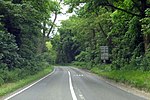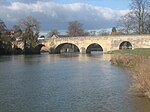Benson Lock
Locks of BerkshireLocks of OxfordshireLocks on the River ThamesUse British English from January 2017Weirs on the River Thames

Benson Lock is a lock on the River Thames in England, close to Benson, Oxfordshire but on the opposite bank of the river. The first pound lock here was built by the Thames Navigation Commission in 1788 and it was replaced by the present masonry lock in 1870. The distance between Benson Lock and Cleeve Lock downstream is 6.5 miles (10.4 km) - the longest distance between locks on the River Thames.The weir runs from the lock island level with the lock across to the Benson side. There is a footbridge over the weir which replaced the ferry which operated here previously. The Thames Path crosses the river here.
Excerpt from the Wikipedia article Benson Lock (License: CC BY-SA 3.0, Authors, Images).Benson Lock
A4074, South Oxfordshire
Geographical coordinates (GPS) Address Nearby Places Show on map
Geographical coordinates (GPS)
| Latitude | Longitude |
|---|---|
| N 51.61631 ° | E -1.11748 ° |
Address
A4074
OX10 6SJ South Oxfordshire
England, United Kingdom
Open on Google Maps









